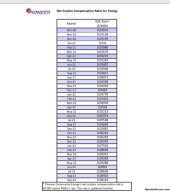It seems that the Community Enegery Electric Generation Charges "CEGC" stated around Sept of 2022. You automatically got put in and set up with you local provider unless you opted out and stayed with the utility. Before you had to (or could) pay the NEM the electric charges at the end of your year. Or if you have a credit, it was wiped out and you stated new at the new year. Now it seems like you have to pay if you use more in any one month than you generate. So no more net over a year. Is that right? You could generate more than you use at the end of your year and get a credit at the end of the year that you could use to pay the "CEGC" charges for the coming year. Seems a bit confusing because the utility also charges for the power in a separate section, and the "CEGC" charges it again in a separate section. I'm guessing you are not charged 2x, but it is not easy to understand.
If you have solar PV, what is the best strategy then? Generate more than you use every month of the year? Generate extra over a year and use the credit to off set the community generation charges? Other?
If you have solar PV, what is the best strategy then? Generate more than you use every month of the year? Generate extra over a year and use the credit to off set the community generation charges? Other?




